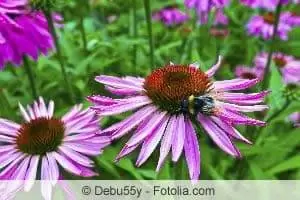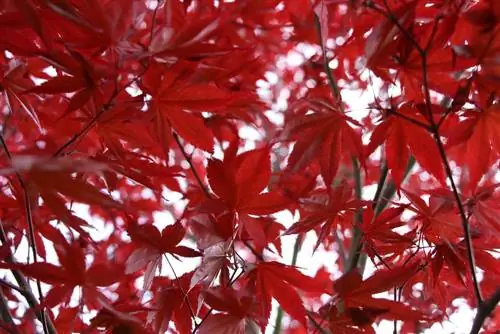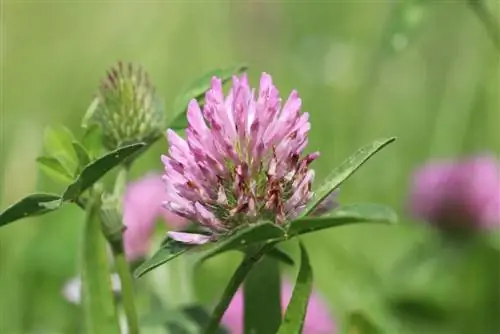- Author admin [email protected].
- Public 2023-12-17 03:39.
- Last modified 2025-01-24 12:45.
The plant is a permanent bloomer and therefore offers flower lovers a long-lasting ornament. The plant combines well with other perennials and even herbs and grasses. The different varieties, which bring a variety of colors to the garden landscape, are also popular. Colors such as white, pink and other color nuances can complete the picture here. Generous garden areas offer the plant the opportunity to develop its wild character, which it owes to its origins. In addition to being grown as an ornamental plant, Echinacea purpurea is also known for its valuable properties as a medicinal plant. The healing effects of the plant are used for colds and to strengthen the immune system.
Floor
The red coneflower can be found wild in sparse forests. In open fields and garden borders, the plant prefers permeable and nutrient-rich soil. The soil around the plant may be loosened from time to time so that it remains permeable for irrigation. The soil should not be too dry to provide the plant with a suitable environment. The perennial plant can reach a height of 80 to 160 cm. So that the flower can fully develop its well-known splendor, the plant should not be exposed to too much shade.
Fertilize
Compost is an ideal fertilizer for the plant. In spring and autumn, the robust plant enjoys the addition of compost around the perennial. This means that the red coneflower is supplied with enough additional nutrients so that the addition of commercially available fertilizers is hardly necessary.
Cutting
When should the red coneflower be cut back in order to have something of the plant for a long time? Every 3 or 4 years after flowering, it is worth cutting back the plant to 10 cm above the ground level. So that it can continue to develop its full flowering potential in nutrient-rich soil, the plant can be separated from the old soil with a spade after pruning and lifted to be used again in another suitable location. In general, it makes sense to remove spent parts of the plant at your discretion so that new flowers can grow back quickly. The red coneflower has a relatively late shoot.
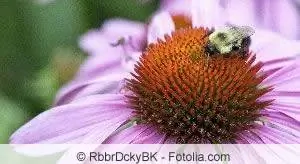
Wintering
The frost-hardy plant is very robust and easy to care for, even in cold temperatures. A layer of mulch provides additional protection for the hardy plant.
Usage
The red coneflower is primarily known as a medicinal plant, but is also often used as an ornamental plant and even as a cut flower. As a remedy, the red coneflower is primarily characterized by its immune system-strengthening effect. The red coneflower is also said to have an antiseptic and antibiotic effect and activates the phagocytes in the blood, which then destroy the disease-causing bacteria. It is used in many different medicines and is a particularly good remedy for the onset of a cold. In addition to being used as a medicine for colds, the pressed juice or the dried herb of the red coneflower can be helpful for respiratory and urinary tract infections.
It can also be used externally for injuries, ulcers and inflammation of the skin. The fresh juice of the plant from the flowering and above-ground parts is processed into a medicine. But dried above-ground parts of plants or the roots are also processed into a natural remedy. If you suffer from an infectious disease or want to increase your immune system in the event of flu, a cold, inflammation of the respiratory tract or swollen glands, you can take a tincture, honey with red echinacea or mixed resistance drops. These remedies also help as preventative measures to increase the immune system.
For external use, compresses with a diluted tincture are used or a few drops of echinacea tincture are applied directly to the wounds. Red echinacea can also be given to children for internal use.
Tip:
However, it is important to ensure that the tincture was prepared without alcohol. There are special mixtures enriched with sweet honey for children.
Frequently asked questions
How far away should the neighboring plants be from the red coneflower so that it does not reduce its growth?
Plants with a medium-high growth that do not crowd the perennial are well suited in the vicinity of the red coneflower.
How much water can the plant tolerate?
It is generally important to avoid waterlogging when watering the red coneflower.
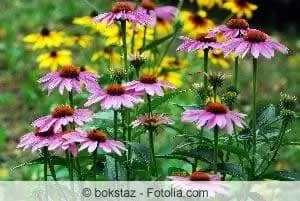
What you should know about the red coneflower soon
- The red coneflower is native to North America, but is now cultivated worldwide as a medicinal and ornamental plant.
- In the wild, this plant can be found primarily in sparse forests, on nutrient-rich and permeable soil in a sunny location.
- The red coneflower is a perennial plant that can grow between 80 and 160 cm tall.
- What is striking about this plant are the flowers, which are very similar to the daisy. The flowers can reach a diameter of up to 14 cm.
- The typical flowering period of the red coneflower is from June to September.
- The ideal location for planting red coneflower is a full sun spot.
- The plant prefers nutrient-rich, permeable and humus-rich soil and should be fertilized in spring and late summer.
- Otherwise, the red coneflower is considered very frugal and easy to care for.
- Withered leaves of the red coneflower should be cut off. This means there is a possibility that new petals will form very quickly.
- In autumn the entire plant is cut back to the ground. A layer of mulch then protects it from the frosty temperatures in winter, even if the red coneflower is hardy.
- In spring you can propagate the red coneflower using the division method. This should be done every three to four years for existing plants.
- As an alternative to division, propagation can also be done by sowing.
- Cutting root cuttings is also possible.
- The individual plants should be planted at a distance of approx. 40 cm from each other.
- In spring it should be ensured that the Red Sugar Loaf is well protected from snails.

